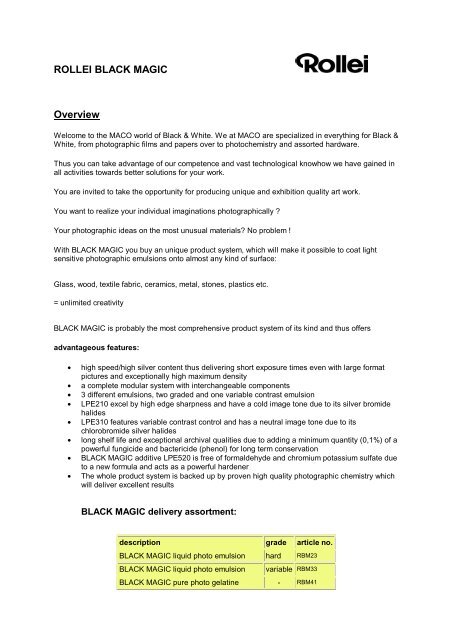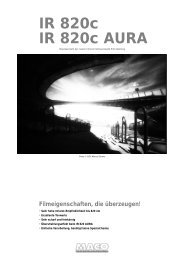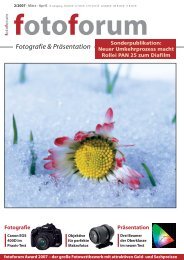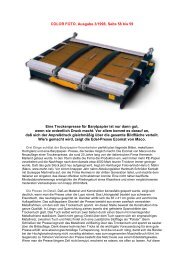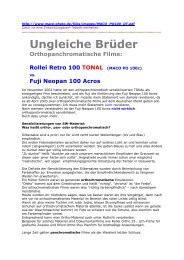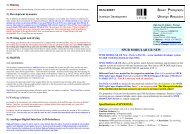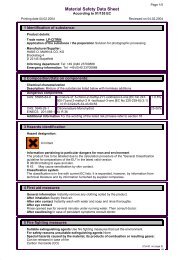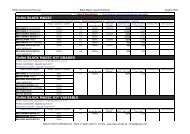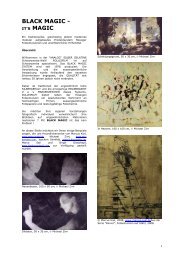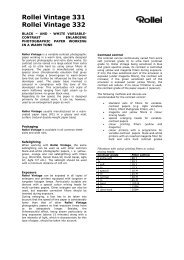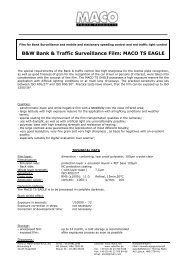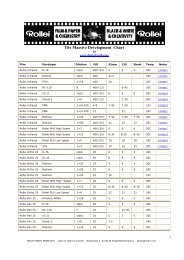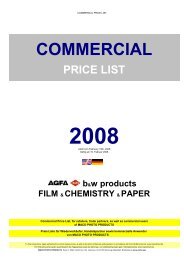ROLLEI BLACK MAGIC Overview - HANS O. MAHN & CO. KG
ROLLEI BLACK MAGIC Overview - HANS O. MAHN & CO. KG
ROLLEI BLACK MAGIC Overview - HANS O. MAHN & CO. KG
Create successful ePaper yourself
Turn your PDF publications into a flip-book with our unique Google optimized e-Paper software.
<strong>ROLLEI</strong> <strong>BLACK</strong> <strong>MAGIC</strong><br />
<strong>Overview</strong><br />
Welcome to the MA<strong>CO</strong> world of Black & White. We at MA<strong>CO</strong> are specialized in everything for Black &<br />
White, from photographic films and papers over to photochemistry and assorted hardware.<br />
Thus you can take advantage of our competence and vast technological knowhow we have gained in<br />
all activities towards better solutions for your work.<br />
You are invited to take the opportunity for producing unique and exhibition quality art work.<br />
You want to realize your individual imaginations photographically ?<br />
Your photographic ideas on the most unusual materials? No problem !<br />
With <strong>BLACK</strong> <strong>MAGIC</strong> you buy an unique product system, which will make it possible to coat light<br />
sensitive photographic emulsions onto almost any kind of surface:<br />
Glass, wood, textile fabric, ceramics, metal, stones, plastics etc.<br />
= unlimited creativity<br />
<strong>BLACK</strong> <strong>MAGIC</strong> is probably the most comprehensive product system of its kind and thus offers<br />
advantageous features:<br />
• high speed/high silver content thus delivering short exposure times even with large format<br />
pictures and exceptionally high maximum density<br />
• a complete modular system with interchangeable components<br />
• 3 different emulsions, two graded and one variable contrast emulsion<br />
• LPE210 excel by high edge sharpness and have a cold image tone due to its silver bromide<br />
halides<br />
• LPE310 features variable contrast control and has a neutral image tone due to its<br />
chlorobromide silver halides<br />
• long shelf life and exceptional archival qualities due to adding a minimum quantity (0,1%) of a<br />
powerful fungicide and bactericide (phenol) for long term conservation<br />
• <strong>BLACK</strong> <strong>MAGIC</strong> additive LPE520 is free of formaldehyde and chromium potassium sulfate due<br />
to a new formula and acts as a powerful hardener<br />
• The whole product system is backed up by proven high quality photographic chemistry which<br />
will deliver excellent results<br />
<strong>BLACK</strong> <strong>MAGIC</strong> delivery assortment:<br />
description grade article no.<br />
<strong>BLACK</strong> <strong>MAGIC</strong> liquid photo emulsion hard RBM23<br />
<strong>BLACK</strong> <strong>MAGIC</strong> liquid photo emulsion variable RBM33<br />
<strong>BLACK</strong> <strong>MAGIC</strong> pure photo gelatine - RBM41
1. Safety first<br />
<strong>BLACK</strong> <strong>MAGIC</strong> ADDITIV HD* concentrate - RBM52<br />
<strong>BLACK</strong> <strong>MAGIC</strong> special bottle for warming<br />
up small amounts, lighttight<br />
- RBM60<br />
In all areas of life, any product may be harmful if not used properly. Of course this applies also to<br />
photographic products.<br />
We at MA<strong>CO</strong> care about our customers and our responsibility in regard of environmental aspects.<br />
Therefore we have kept any potential health hazards to a minimum. However we urge you to use<br />
appropriate caution in handling our photographic products.<br />
• Always keep the products out of the reach of children !<br />
• Please read the instructions carefully - if in doubt please contact us for support.<br />
• Working with photographic chemistry should take place in rooms with good ventilation.<br />
• Furthermore, we keep Material safety data sheets available.<br />
See Safety data sheets above.<br />
2. Usage<br />
The use of <strong>BLACK</strong> <strong>MAGIC</strong> should take place in a black & white darkroom.<br />
The graded <strong>BLACK</strong> <strong>MAGIC</strong> emulsions LPE 210 may be mixed together in any ratio.<br />
3. What do you need - a checklist<br />
Depending on your goal, you should have all necessary components at hand. If you miss an important<br />
tool or material during your work it is too late. Most items are ready available in a well equipped<br />
darkroom - but some are special and have to be organised before your coating session:<br />
Checklist:<br />
1. First you have to decide what type of material you want to coat (see chapter 8 for detailed<br />
information).<br />
2. Check the contrast of the negatives you want to use - do you have different grades, then go<br />
for <strong>BLACK</strong> <strong>MAGIC</strong> VC emulsion RBM33, or do you have fairly consistent contrast negatives,<br />
then go for <strong>BLACK</strong> <strong>MAGIC</strong> hard RBM24.<br />
3. For most coating applications the method of brushing will prove to be the best - get yourself a<br />
wide brush (5-10 cms/ 2"-4" width) made of natural hair, e.g. a Japan brush.<br />
4. Keep small measures for quantities of 20-50cc at hand, it will be useful for adding small<br />
amounts of RBM52.<br />
5. For coating metal, plastic, glass or ceramic tiles, a precoat with alkyd resin primer or oil-based<br />
polyurethane paint should be carried out, these special primers are available at art shops.<br />
6. If you have absorbent materials such as textile fabric, papers or wood it is recommendable to<br />
precoat these materials with <strong>BLACK</strong> <strong>MAGIC</strong> pure photographic gelatin RBM41.<br />
7. For liquification, you will need a bucket to be filled with warm water (40-45°C / 100 - 115 F).<br />
8. If you want to liquify just a small amount, you need <strong>BLACK</strong> <strong>MAGIC</strong> special bottle RBM60.<br />
9. For keeping a bigger amount liquified in order to coat large areas or several objects, it is best<br />
to fill the liquified emulsion into a smaller bucket (plastic or stainless steel or enamel coated
only) and place this bucket into a larger container filled with warm water to keep the emulsion<br />
liquified.<br />
10. For improving mechanical resistance you need <strong>BLACK</strong> <strong>MAGIC</strong> ADDITIV HD RBM52.<br />
11. In order to make coating easy and keep the problem of unwanted bubbles low you need spirit<br />
(grain alcohol).<br />
12. Check your safelight before coating, in order to avoid unwanted fogging (see chapter 7 for<br />
details).<br />
13. If you want to store materials coated with light-sensitive emulsion, have enough lighttight<br />
containers at hand, the containers should be designed in a way that these will cope with the<br />
wet emulsion (high moisture).<br />
4. How much area can be coated<br />
With non-absorbent materials, you can coat up to 8 m², with absorbent materials you can coat up to 4<br />
m².<br />
In practical use, this may vary due to the thickness of the coating and the absorbent properties of the<br />
chosen material.<br />
5. How do you store <strong>BLACK</strong> <strong>MAGIC</strong><br />
The liquid emulsions RBM23 and RBM33 should be stored in the refrigerator (6°C-8°C / 40 - 46 F).<br />
All other components, RBM41, RBM52 and RBM60 can be stored at room temperature.<br />
6. How long is the shelf life<br />
If stored according to our instructions, shelf life will be one year. If you deep freeze RBM23 and<br />
RBM33 at temperatures below -10 C° / 14 F shelf lif e will be extended by far.<br />
7. What type of Safelight is suitable<br />
7. What type of Safelight is suitable<br />
RBM23: red or yellow green<br />
RBM33: red or light brown, no yellow green<br />
Keep in mind, that silver halides collect light in difference to the human eye.<br />
Therefore, it is advisable to keep safelight exposure to a minimum. In reality no safelight is really safe -<br />
it's just a matter of exposure time. We recommend to do a fogging test under your own conditions -<br />
this is especially important if you want to coat large areas or many objects.<br />
Carry out a trial coating and let it be exposed partially by your safelight at the place you want to coat<br />
all other materials. Place a black cardboard on top and move it in a way that you have an exposure<br />
bracketing of 15 minutes/ 30 minutes/ 45 minutes and so on.<br />
Develop and see whether any exposure shows a gray fogging. If this is the case move or change your<br />
safelight.
8. What different approach is recommended for each type of material<br />
to be coated<br />
Depending on the chosen material, the thoroughness of your preparation will be decisive for your final<br />
art work.<br />
All materials have to be free from dust and grease. If in doubt clean twice - any trace of grease will<br />
lead to adhesion problems.<br />
After you have selected a material to be coated, there is a different approach for 3 main groups of<br />
materials:<br />
1. Absorbent materials such as fabric, papers or wood;<br />
if you want to prevent the emulsion to be soaked into the base, a precoat with <strong>BLACK</strong> <strong>MAGIC</strong><br />
RBM52 - pure photo gelatine has to be made (also called baryta solution, but without barium<br />
sulphate).*<br />
2. Smooth and/or hard surfaces such as polished stone, glass or metal;<br />
we recommend also a precoat with RBM52in combination with RBM41 - hardening additive<br />
solution (to improve adhesion and mechanical qualities).<br />
If you encounter that the emulsion comes off during processing, precoat these materials with<br />
clear alkyd resin primer or oil-based polyurethane paint (available at art material shops).<br />
Note on metal:<br />
Due to the electrochemical reaction chain (there is low electrical current between precious and<br />
non-precious metals) it is important to coat an isolation layer onto the metal surface before<br />
coating the light sensitive emulsion.<br />
For doing so you can use either a white enamel paint or a clear alkyde resin paint.<br />
Be sure that this precoat has dried off completely, as any remaining solvent will show up in<br />
your final result..<br />
Note on plastics:<br />
As all plastics (acrylic etc.) are being produced in a way that embodies anti adhesion<br />
additives, the emulsion will come off during processing. Therefore, it is necessary to coat<br />
these materials with paint which sticks to the emulsion, withstands the photographic<br />
processing and delivers good adhesion to the emulsion. Try the a.m. alkyde resin paint.<br />
3. All other materials can be coated directly with <strong>BLACK</strong> <strong>MAGIC</strong> photographic emulsion.<br />
With 3-D objects several thin coats ensure high maximum density (after setting before<br />
complete drying).<br />
How to make a baryta solution: (this step may be carried out under normal lighting conditions)<br />
Warm up 1000cc tab water until 70°-80°C and dissolv e completely 40 grms of RBM41 by continuous<br />
stirring, until free of lumps. To reduce surface tension you may add a few drops of LP-<br />
MASTERPROOF (wetting agent with bactericide and fungicide additives) to your solution, this makes<br />
it easier to evenly coat smooth /hard materials. Coat your material directly afterwards. To improve<br />
hardening of the emulsion add 20 - 50 cc of <strong>BLACK</strong> <strong>MAGIC</strong> additive RBM52 to your solution. Since<br />
you coat under normal lighting conditions even coating will be much easier.<br />
Note about hardening:<br />
You can harden indirectly by adding <strong>BLACK</strong> <strong>MAGIC</strong> additive RBM52 to the baryta solution and harden<br />
directly by adding <strong>BLACK</strong> <strong>MAGIC</strong> additive RBM52 to the light sensitive photographic emulsion (in this<br />
case, please use the photographic emulsion within 2 hours). For better adhesion of the coating and to<br />
improve mechanical resistance of the surface you may combine both methods.<br />
Furthermore, you can add <strong>BLACK</strong> <strong>MAGIC</strong> additive RBM52 directly to the developer.
9. How do you combine the modular components of the <strong>BLACK</strong><br />
<strong>MAGIC</strong> system<br />
The graded <strong>BLACK</strong> <strong>MAGIC</strong> emulsion RBM23 may be mixed together in any ratio, to achieve in<br />
between grades. For a wide range of contrast control use <strong>BLACK</strong> <strong>MAGIC</strong> RBM33.<br />
For absorbent materials use <strong>BLACK</strong> <strong>MAGIC</strong> RBM41, it is a purified photo gelatin, much cleaner than<br />
gelatin for food, and add for improved mechanical resistance <strong>BLACK</strong> <strong>MAGIC</strong> ADDITIV HD RBM52<br />
instructions at the end of this manual, due to its special formula you can add RBM52 also to the<br />
emulsion itself and to the developer.<br />
It's much easier to warm up partial amounts of emulsion if you use RBM60, the special bottle is<br />
lighttight and thus you avoid warming up the complete bottle - spare time and keep the emulsion<br />
quality high.<br />
Spirit (grain alcohol) is recomended in order to get rid of bubbles which almost always occur. Add 10-<br />
20cc of it directly into the liquified emulsion (amount based on 500cc). If you have a longer coating<br />
session, you can add spirit (grain alcohol) every 20 minutes.<br />
10. How to achieve different image tones<br />
If you decide to precoat your material with <strong>BLACK</strong> <strong>MAGIC</strong> RBM41, you can add water soluble<br />
photographic dyes to the solution - add as much until you have the desired tone, usually a few drops<br />
will suffice.<br />
11. How does the liquification take place<br />
Take out <strong>BLACK</strong> <strong>MAGIC</strong> photographic emulsion of your refrigerator and...<br />
Carry out following working steps under safelight conditions !<br />
Either take out the needed amount out of the bottle by using a solid plastic or stainless steel spoon fill<br />
it into the special bottle (article RBM60) and liquify it up in a bucket filled with warm water (35-40°C).<br />
For larger application projects warm up the original bottle by the same means.<br />
Note:<br />
For first trial coatings or smaller objects to be coated just take out needed amounts (under darkroom safelight) out of the original<br />
bottle , put them into a graduate and liquify by warming up in a container (or bucket) filled with warm water. By doing so you will<br />
ensure the quality of <strong>BLACK</strong> <strong>MAGIC</strong> (repeated warming and cooling harms light sensitive products).<br />
If you want to coat larger objects (e.g. ceramics, stones) you may heat them in your oven (30-40°C /86<br />
-104F) so your emulsion won't set while you are still coating.<br />
12. What are the different ways of coating<br />
If you have never worked with <strong>BLACK</strong> <strong>MAGIC</strong> photographic emulsion before, you can train the coating<br />
procedure with coffee cream since this liquid has a similar viscosity.<br />
You can coat your objects different ways:<br />
pour and pan = with flat and rigid materials such as tiles, metal plates etc.<br />
pour and brush = with almost all materials<br />
dip and dunk = with smaller 3-dimensional objects
spray * = with large and complex structured objects<br />
* Use only spray guns with large jet opening, an air brush is not suitable.Wear protective clothing/mask to avoid inhaling spray particles.<br />
For most applications best results will be achieved by using a brush with natural hair (e.g. Japan<br />
brush).<br />
We recommend to coat test stripes at the same time for determining the correct exposure later on.<br />
Preferably of the same material or the backside of photographic paper).<br />
Excessive emulsion may be reused immediately.<br />
Note:<br />
By using an spray gun, you can adjust viscosity with distilled water up to an ratio of 1:1.<br />
By doing so spray several layers.<br />
Setting stage:<br />
Cooling and setting stage follows directly after coating. In this stage the coated surface is very<br />
delicate. Setting will take about 1 to 2 hours. You can speed up setting by storing the coated materials<br />
in the refrigerator for about 30 min. To avoid unwanted exposure either use a light-tight container or<br />
unscrew the bulb of your refrigerator.<br />
Drying stage:<br />
Now you can dry the coated materials.<br />
You can do so by using a hair dryer at low heat setting and midrange distance to avoid melting of the<br />
emulsion. Check hair dryer by turning it on in the dark before using it to make sure there is no<br />
electrical spark or glowing of the heat wires which could cause an exposure. Of course you can store<br />
objects in your darkroom (Do not turn on room light!) and let them dry off. This will take between<br />
several hours and 1 day depending on the kind of object and humidity.<br />
13. Exposure - what do you have to consider<br />
Procedure is similar to standard photographic paper, especially if you have coated flat materials. With<br />
3-dimensional objects close down your enlarging lens to the maximum to reach maximum depth of<br />
field. (Note that by stopping down your lens, depth of field will be 1/3 before and 2/3 behind point of<br />
focus)<br />
Hint: With cylindrical or evenly formed objects you can produce a large halftone negative(or if you wish<br />
also a graphic negative without grey values) by using GENIUS Litho Film. This negative can then be<br />
laid or taped onto your coated object (e.g. a bottle or a vase) and then turn it evenly under the<br />
enlarging light - by doing so a sharp and even exposure will be a lot easier !<br />
Note:<br />
Note:<br />
If you have used LPE310 for coating, you can change grades for optimum<br />
photographic results. This can be done equivalent to standard variable<br />
contrast photographic papers (e.g. MA<strong>CO</strong> Multispeed 1F and Multibrom F<br />
or AGFA Multicontrast etc.)<br />
either with filters for your filter drawer (e.g. LABOR PARTNER Fil 8,<br />
ORIENTAL Acrylicfilter,or ILFORD Multigrade Filter)<br />
or with enlargers with Variocontrast - or Colorhead by turning the corresponding<br />
filter values:<br />
Yellow = for softer image reproduction<br />
Magenta = for harder image reproduction<br />
In case you exposure was to intense, you can bleach until desired density is reached by using<br />
LABOR PARTNER LP-SEPIA PART A, Art. No. LPH51A, dilution 1+30.
14. Processing - what is important for good results<br />
Due to the high silver content, use high energy photographic chemistry only.<br />
LABOR PARTNER photochemistry is especially well suited for <strong>BLACK</strong> <strong>MAGIC</strong>. Keep working<br />
temperature to a max. of 20°C or lower, to avoid da maging of the emulsion.<br />
Developer:<br />
Rollei RPN, for universal application<br />
Rollei RHC, for steeper grade<br />
Short rinse: Rinse with tab water or dunk in water filled tray to for 10-20 seconds<br />
Stopbath: Rollei CITRIN, odorless, non allergic and environmentally friendly<br />
Fixer:<br />
Rollei RXA, pH-neutral for non acidic fixing, improved archival quality,<br />
avoids sulphur dioxide emissions, shorter washing times<br />
Washing: tab water, 68 F / 20°C, duration depending on coati ng thickness and base material.<br />
Wetting agent: Rollei RWA, 3rd generation, with bactericide and fungicide additives<br />
After<br />
treatment:<br />
Rollei SELENIA, unsurpassed quality for protection of image silver, improved image<br />
brilliance<br />
Drying: Air drying, in case of need use a hair dryer<br />
Hints for processing<br />
• avoid mechanical influences onto the coated emulsion, (e.g. touching with hands or chemistry<br />
tongs) even though hardening may has taken place, emulsion is very delicate<br />
• lay or position your object into a large enough tray and pour (or cautious dunking) your<br />
chemistry onto it with caution.<br />
Proceed in the sequence developing - stop - fix - washing (p.4)<br />
• with larger objects (heavy objects, room walls etc.) which can not be processed by described<br />
means, pour the chemistry with a graduate or even a watering can onto your object starting<br />
from bottom and going up to the top. Procedure identical to a.m. steps<br />
• always use fresh fixer and keep fixing time as short as possible - you will be rewarded<br />
with short washing times<br />
• fixer with hardener may not be used, because the extensive washing time will damage the<br />
emulsion.<br />
15. Notes on special aspects<br />
• since <strong>BLACK</strong> <strong>MAGIC</strong> is a very versatile product, so before you have gained any experience<br />
you should follow our application information closely - later on, your own experience and your<br />
creativity will be the best coach.<br />
• in addition you can protect finished objects by coating them e.g. with a clear polyurethane<br />
paint.<br />
• if you wish to coat any metal objects, be sure to prime an undercoat before coating with light<br />
sensitive (containing a silver compound) emulsion in order to avoid an electrochemical<br />
reaction.You can use RBM41 pure photographic gelatin.<br />
• <strong>BLACK</strong> <strong>MAGIC</strong> additive RBM52 - is free of formaldehyde and may also be used for emulsion<br />
hardening of films and papers: Dissolve 40 - 80cc of LPE 520 in 1000cc water and dunk the<br />
materials you want to harden for 2 - 3 minutes and let them dry afterwards.<br />
16. Trouble shooting guide<br />
Result reason remedy
Bubbles in the<br />
finished picture<br />
uneven coating<br />
Emulsion take off<br />
during processing<br />
17. Support<br />
heavy stirring or shaking<br />
has caused air bubbles<br />
uneven storage during setting<br />
stage and coat several layers<br />
grease or anti-adhesion<br />
agents on your object<br />
avoid heavy stirring or shaking<br />
add10 - 20 cc of spirit (grain alcohol)<br />
for 500cc Black Magic by slowly stirring<br />
level out your object<br />
thoroughly clean your object<br />
or precoat with alkyde resin paint<br />
If you have questions or any proposals after reading this manual, we are happy to receive your<br />
feedback under<br />
MA<strong>CO</strong> PHOTO PRODUCTS<br />
<strong>HANS</strong> O. <strong>MAHN</strong> & <strong>CO</strong>. <strong>KG</strong>Brookstieg 4, D-22145 Hamburg_Stapelfeld<br />
HOTLINE: ++49-40 - 237 008 - 88<br />
Fax: ++40-40 - 23 35 77<br />
E-mail: PHOTO@mahn.net


